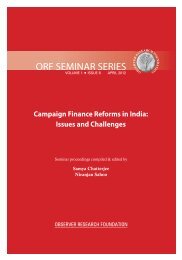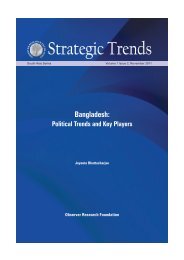ORF ENERGY NEWS MONITOR - Observer Research Foundation
ORF ENERGY NEWS MONITOR - Observer Research Foundation
ORF ENERGY NEWS MONITOR - Observer Research Foundation
Create successful ePaper yourself
Turn your PDF publications into a flip-book with our unique Google optimized e-Paper software.
Renewable Energy / Climate Change Trends<br />
National<br />
Delhi govt buildings to go 'green'<br />
July 20, 2010. In tune with its climate change initiative, Delhi Government has begun the process of converting<br />
15 existing government buildings into 'green buildings' by making them energy efficient. State Environment<br />
Secretary Dharmendra said government will soon issue request for proposal (RPF) for the project, aimed at<br />
cutting down energy consumption in these buildings. The Delhi secretariat, which houses offices of chief<br />
minister and other ministers, will also be converted into a green building under the project. The project is part of<br />
our climate change initiative. As part of its energy conservation measures, Delhi Government has already<br />
decided to implement the Energy Conservation Building Code (ECBC) for government buildings in the national<br />
capital. The ECBC provides guidelines and norms for the energy efficient design and construction of buildings.<br />
It also provides guidelines for reducing energy requirement, environmentally benign design and construction<br />
techniques. One of the targets defined under Enhanced Energy Efficiency Mission is to retrofit 100 existing<br />
buildings with area above 10,000 sqft to make them energy efficient. The environment department has already<br />
made solar water heater system mandatory in industries, hotels, hospitals, nursing homes, hotels, canteens<br />
and residential buildings having an area of 500 sq meter.<br />
TOP<br />
NHDC's 100 MW wind power plant in MP<br />
July 20, 2010. Narmada Hydroelectric Development Corporation (NHDC), a joint venture (JV) between the<br />
Madhya Pradesh government and the National Hydro Power Corporation (NHPC), wishes to set up a 100-Mw<br />
wind power plant in Kukru village of Betul district (250 km from here). It will probably be one of the largest such<br />
plants in the country. The company, formed to tap the potential in hydroelectric power generation on the<br />
Narmada river, has already diversified into thermal power and bagged two super-critical thermal power projects<br />
in the state of 1,360 Mw each. Although capacity utilisation in wind power, if government and wind energy<br />
investors and various other sources are believed, comes to hardly 18-22 per cent in Madhya Pradesh, NHDC is<br />
optimistic on the project. NHDC is confident of optimum utilisation of the plant. At present the wind power rate<br />
starts from Rs 4.03 per unit in first year to Rs 3.36 per unit in the 20th year. Wind power makers have<br />
demanded a slash in power rates.<br />
Renewable energy supply to meet 2015 target: CERC<br />
July 20, 2010. "The renewable energy supply will not be a constraint in meeting the 10% by 2015 target set by<br />
the National Action Plan on Climate Change," Dr Pramod Deo, Chairman, Central Electricity Regulatory<br />
Commission (CERC) said. He added that CERC has conducted a study to assess the supply scenario based<br />
on stakeholder consultation and the study revealed that the supply from renewable energy resources could<br />
exceed 47720 MW by 2015, as against the trend scenario of 54,800 MW. Solar power alone is expected to<br />
supply 4000 MW by 2015. He said that the government is supporting the solar industry by offering a<br />
generation-based incentive to help the industry meet the National Solar Mission target of 20 GW by 2022.<br />
Giving an overview of the renewable industry, Dr Deo said that India has the total installed capacity of 1,61,352<br />
MW as on May, 2010, wherein the total installed capacity of renewable energy is about 10% (17,222 MW).<br />
However, currently renewable energy contributes just 4% of total power generation.<br />
HP to frame policy to harness solar power<br />
July 17 2010. In order to harness the estimated solar power potential of 20,000 megawatt, the state<br />
government is likely to work out a policy to determine the mode of establishing power projects through<br />
alternative energy. Experts believe Spiti valley in Himachal Pradesh is best suited for solar power projects due<br />
to its high altitude and extreme cold conditions. 1 MW and 2 MW solar projects being taken up by Himurja, the<br />
state PSU, would act as pilots to show way for formulating policy in the future.<br />
TOP<br />
India takes a big leap in renewable energy<br />
July 16, 2010. The United Nations listed India as the fifth biggest wind and solar water heating energy producer<br />
in a report. The report, Global Trends in Green Energy 2009, says the developing world is taking a lead in<br />
adopting new renewable technologies. For the first time, private sector green energy investments in Asia and
















